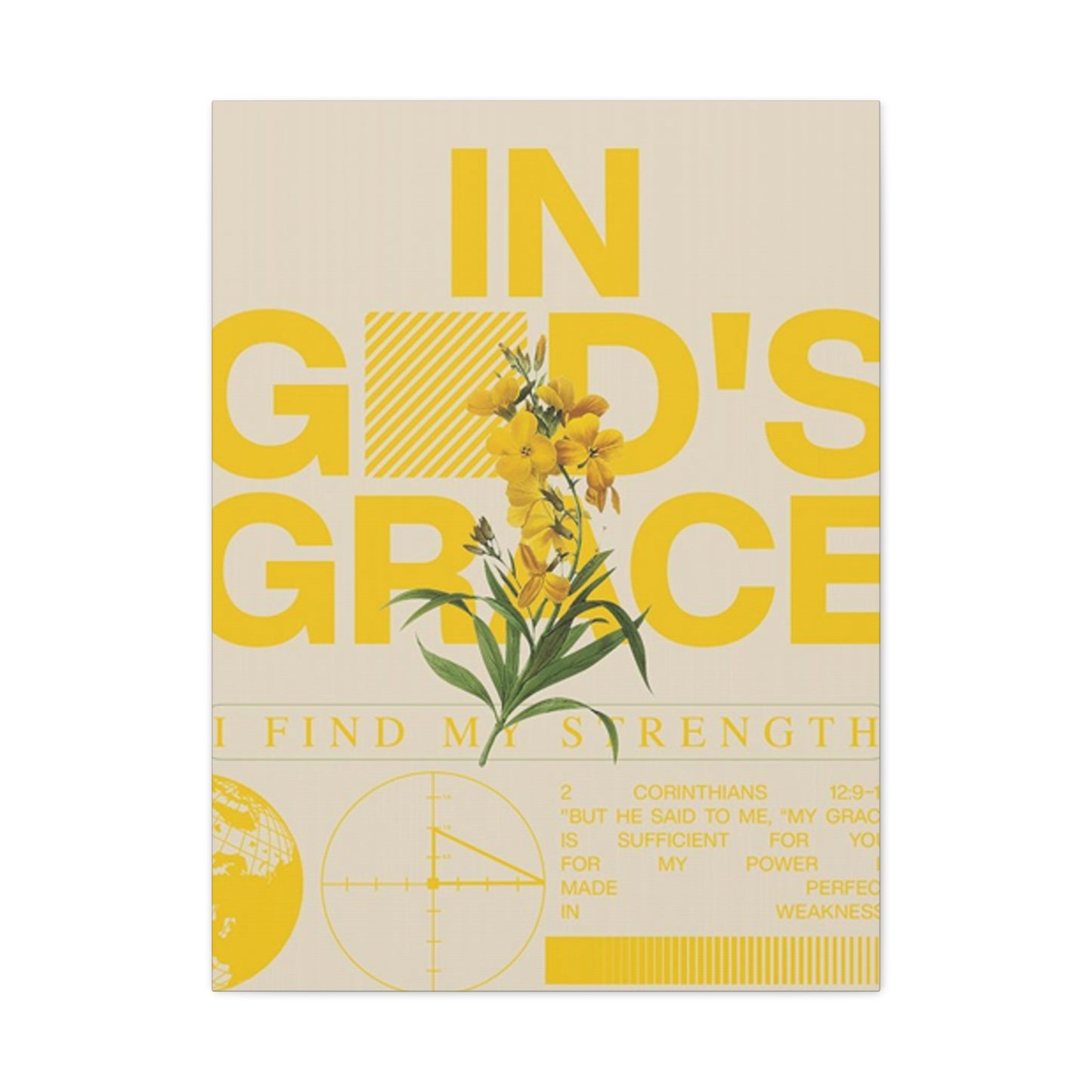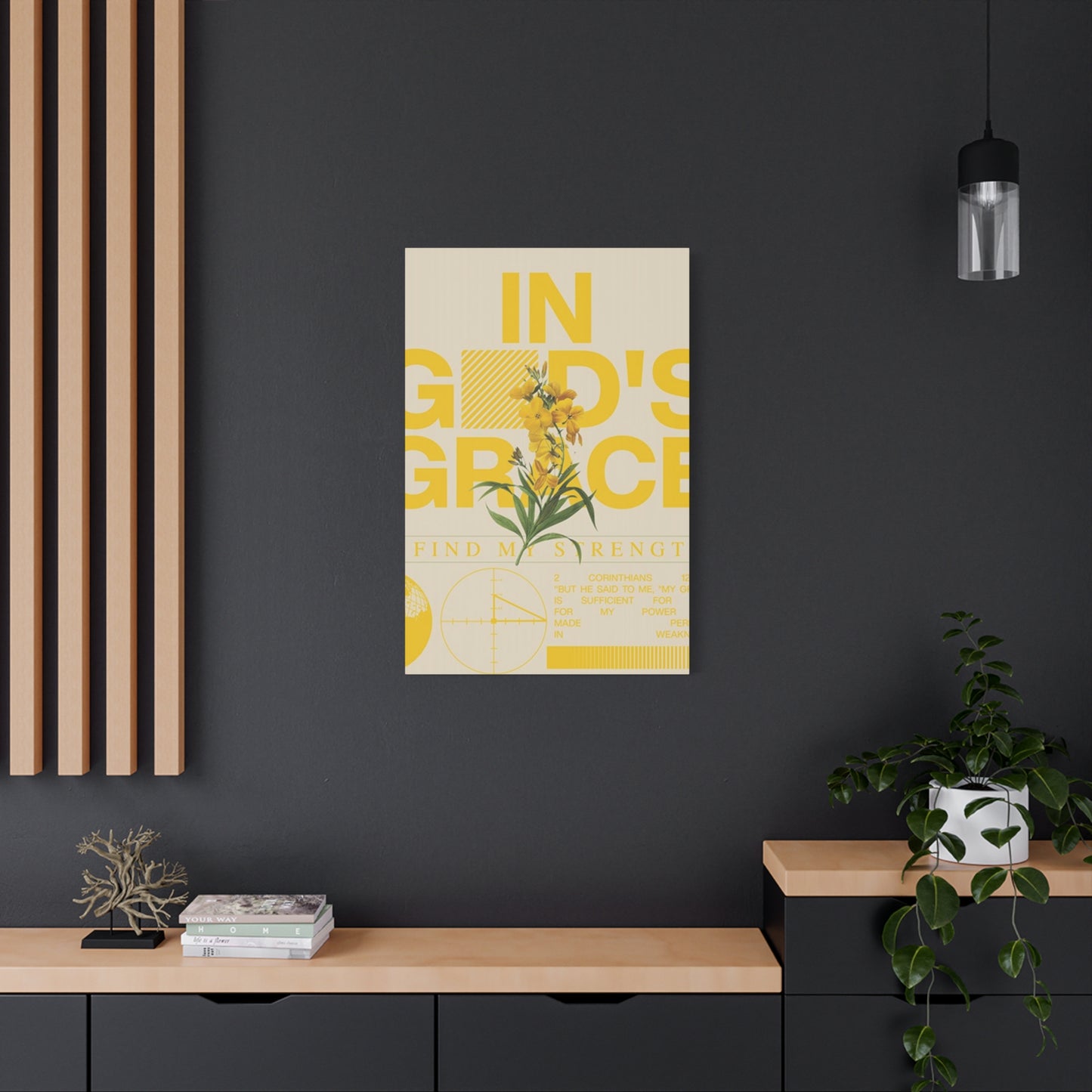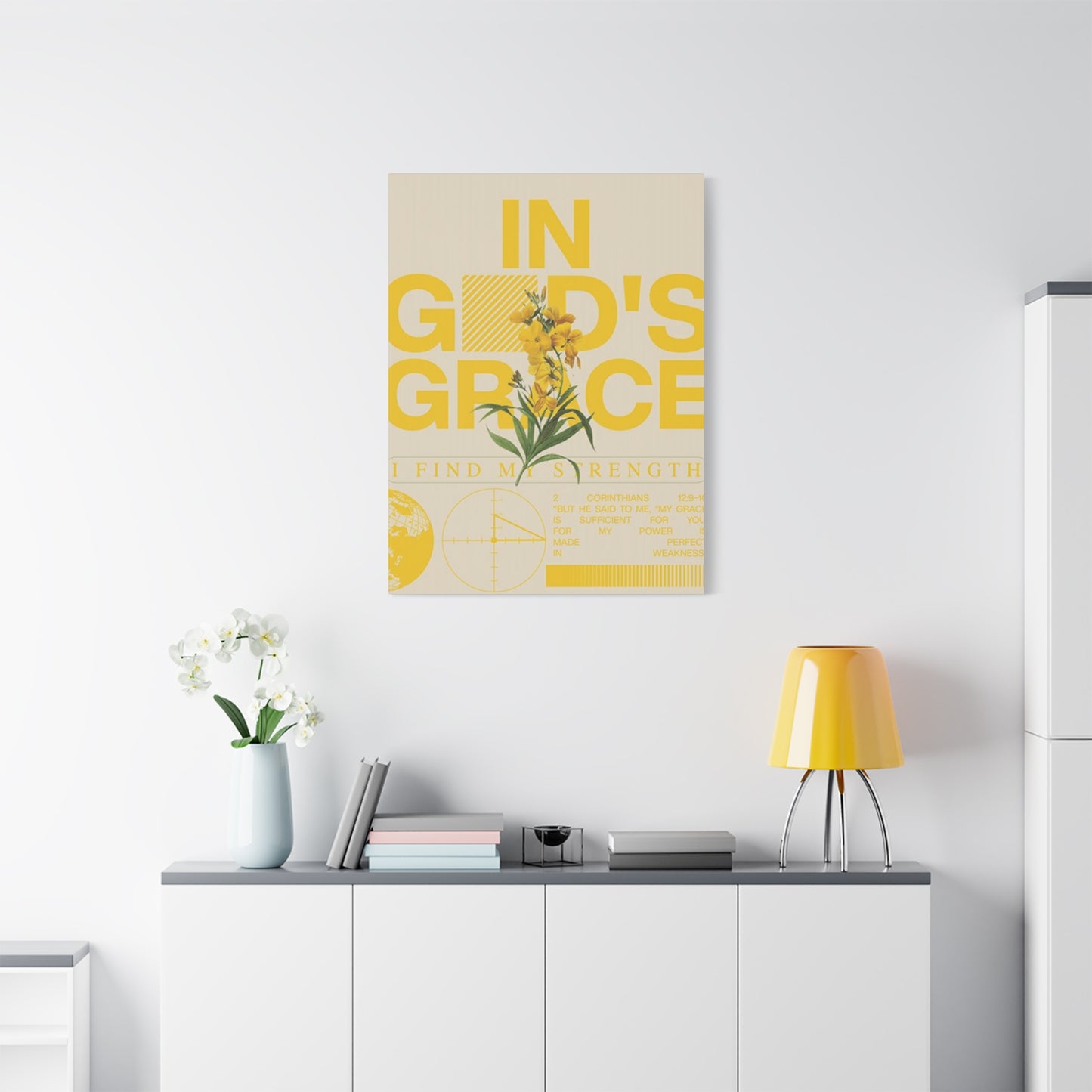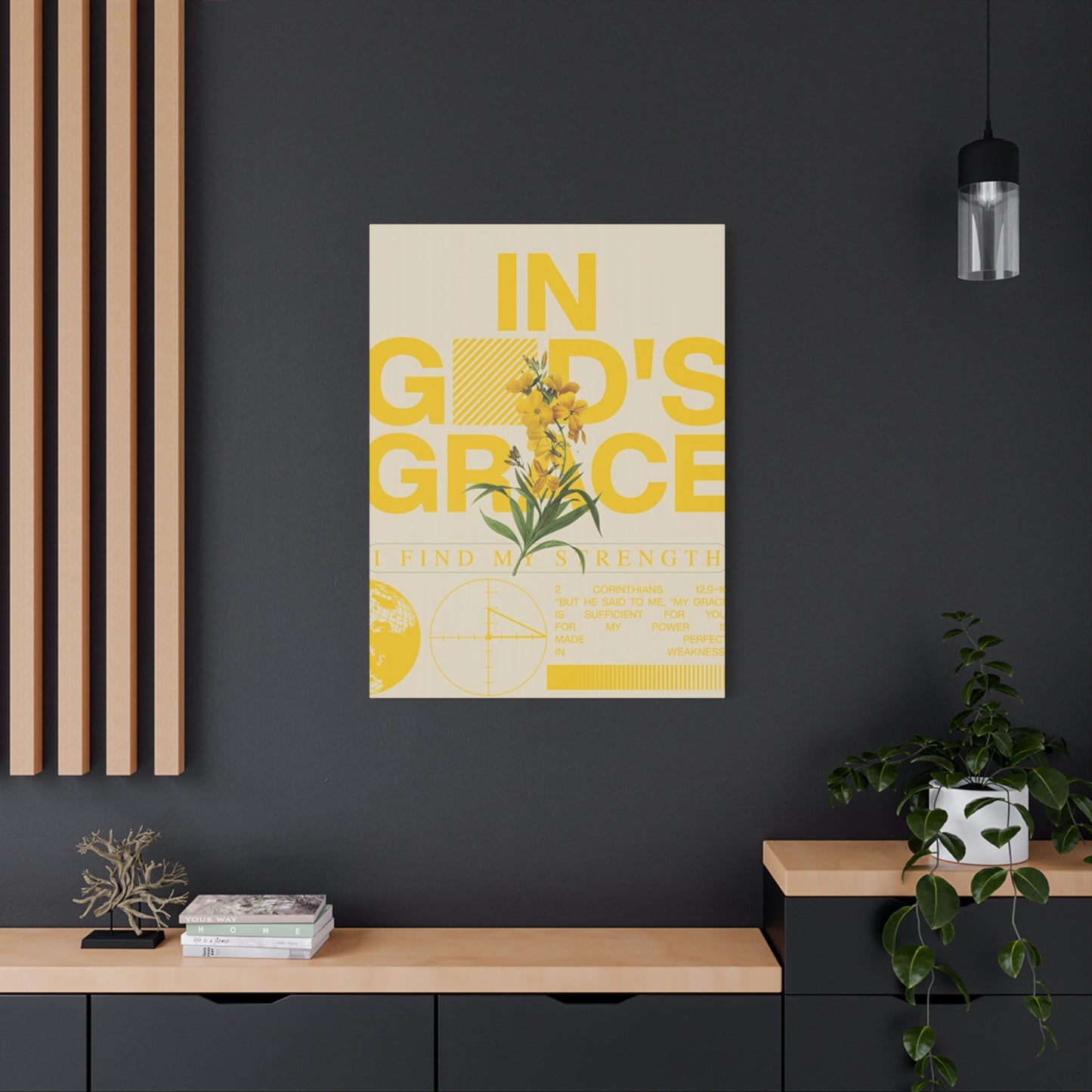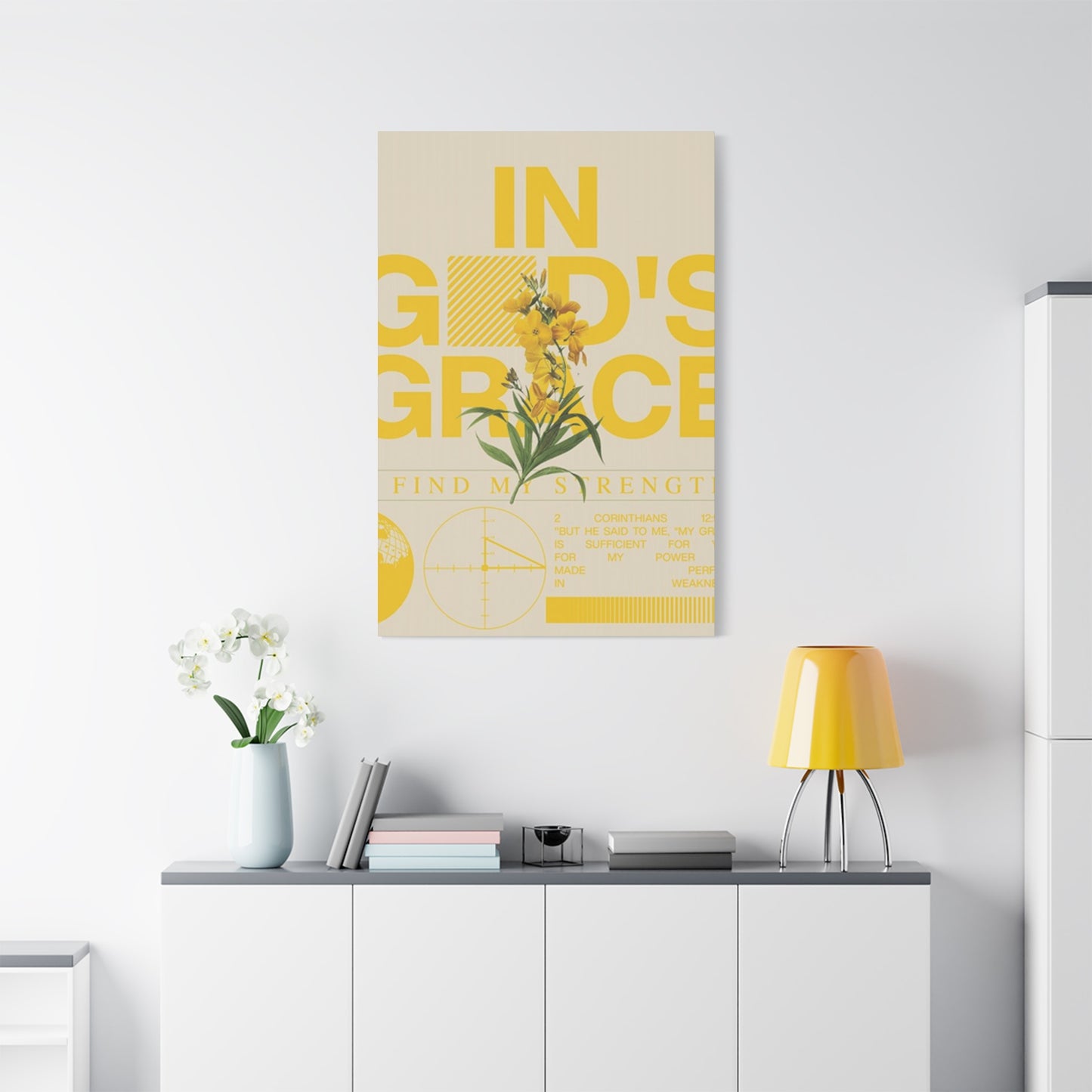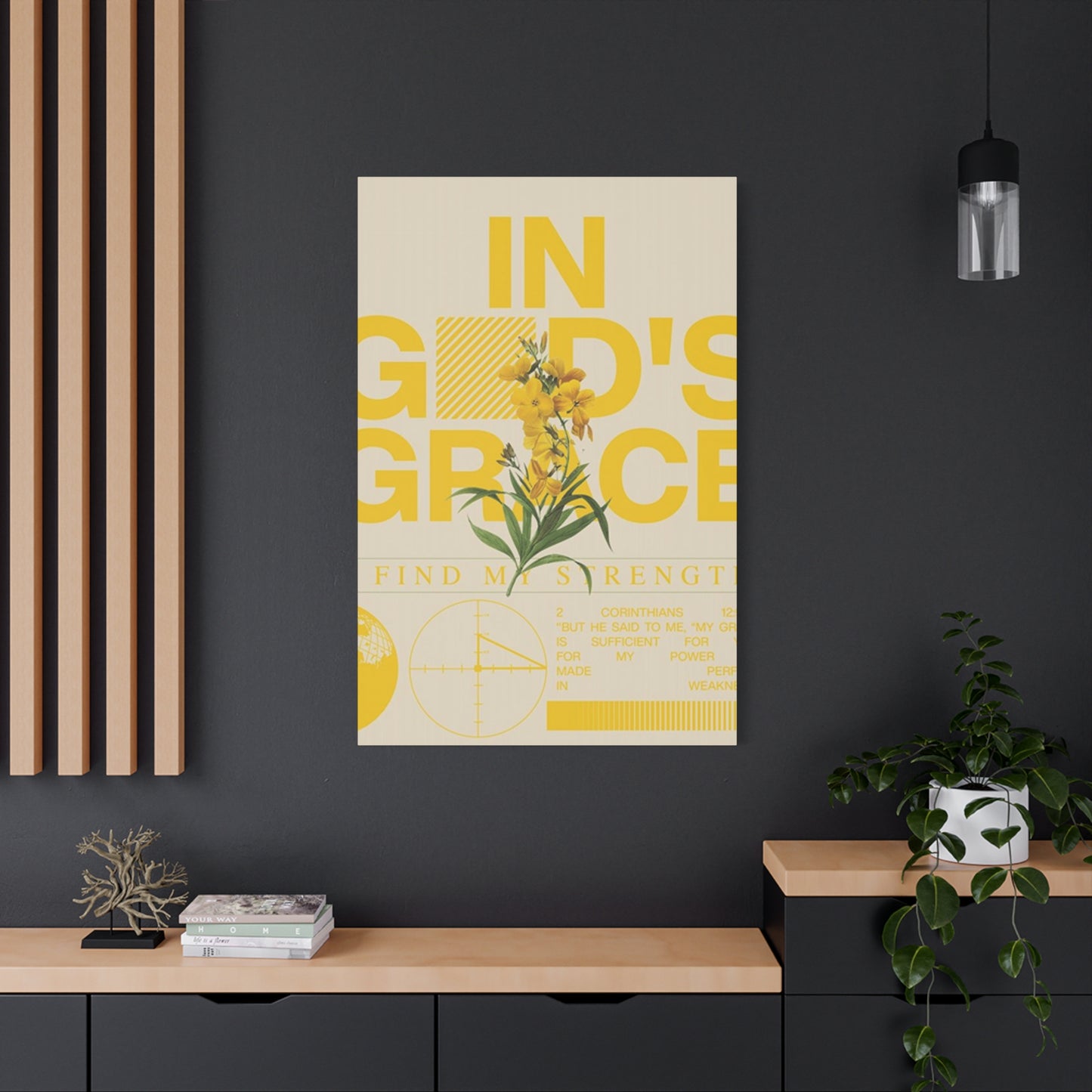In Gods Grace Poster Wall Art & Canvas Prints
In Gods Grace Poster Wall Art & Canvas Prints
Couldn't load pickup availability
In Gods Grace Poster Wall Art: Discovering Sacred Visual Elements That Bring Divine Inspiration Into Your Living Spaces
The realm of spiritual decoration has witnessed a remarkable transformation in recent years, with countless individuals seeking meaningful ways to incorporate their faith into everyday surroundings. Among the most profound expressions of devotion stands the concept of sacred imagery that speaks directly to the soul while enhancing the aesthetic appeal of any room. When we examine the phenomenon of religious artwork designed for home display, we uncover layers of significance that extend far beyond mere decoration, touching upon themes of comfort, contemplation, and connection with the divine.
Sacred visual representations have served humanity for millennia as tangible reminders of intangible truths. From ancient frescoes adorning monastery walls to contemporary prints gracing modern apartments, these expressions of faith create sanctuaries within our homes where we can pause, reflect, and reconnect with our spiritual foundations. The practice of displaying religious imagery transforms ordinary rooms into spaces of reverence, offering daily encounters with messages of hope, love, and divine presence.
The Profound Significance Behind Sacred Visual Representations in Residential Environments
Throughout human civilization, people have adorned their dwelling places with symbols and images that reflect their deepest beliefs and values. This instinctive desire to surround ourselves with meaningful imagery stems from our fundamental need to create environments that nourish not just our bodies, but our spirits as well. Religious artwork serves multiple purposes within the home, functioning simultaneously as decoration, inspiration, and devotional focus.
When we place sacred imagery within our living spaces, we establish visual anchors that ground us in our faith throughout the daily routines of life. These pieces become silent companions, offering encouragement during challenging moments and amplifying joy during celebrations. The presence of spiritual artwork creates an atmosphere that acknowledges the sacred dimension of existence, reminding us that every moment holds potential for divine encounter.
The psychological impact of surrounding ourselves with faith-affirming imagery should not be underestimated. Research into environmental psychology has demonstrated that our surroundings significantly influence our thoughts, emotions, and behaviors. When we intentionally cultivate spaces that reflect our spiritual commitments, we create external environments that support and reinforce our internal values. This alignment between outer space and inner conviction fosters a sense of wholeness and authenticity in daily living.
Religious artwork also serves a communal function, communicating to visitors and household members alike the priorities and principles that guide family life. These visual statements create opportunities for conversation about faith, opening doors to discuss beliefs, values, and the role of spirituality in navigating life's complexities. For families raising children, such imagery provides consistent exposure to religious themes, contributing to the formation of spiritual identity and understanding.
The specific phrase "In Gods Grace" carries particular weight, encapsulating a theological concept central to many Christian traditions. Grace, understood as unmerited divine favor and assistance, represents the cornerstone of faith for millions worldwide. Artwork featuring this phrase serves as a constant reminder of this foundational truth, anchoring believers in the assurance of divine presence and provision regardless of circumstances.
Exploring Various Styles and Formats of Sacred Imagery for Contemporary Homes
The world of religious artwork offers an astonishing diversity of styles, each with unique characteristics and appeal. From classical representations rooted in centuries of artistic tradition to contemporary interpretations that speak to modern sensibilities, the range of available options ensures that every individual can find pieces that resonate with their personal aesthetic preferences while honoring their spiritual convictions.
Traditional religious art often draws upon established iconographic conventions developed over centuries within various faith communities. These pieces typically feature recognizable symbols, scenes from scripture, or depictions of holy figures rendered in styles that evoke historical continuity with the broader community of believers across time. The formal qualities of traditional religious art convey a sense of permanence, stability, and connection to the great cloud of witnesses who have preceded us in faith.
Contemporary sacred art, by contrast, experiments with new forms, materials, and approaches while maintaining fidelity to core spiritual themes. These pieces might incorporate abstract elements, unexpected color palettes, or innovative compositional strategies that challenge conventional expectations while still communicating profound truths. Contemporary religious artwork appeals particularly to those who appreciate modern aesthetics but seek to integrate spiritual substance into their decorative choices.
Typography-based designs represent another popular category, featuring sacred texts, verses, or phrases rendered in visually compelling ways. These pieces prioritize words over images, allowing the power of language itself to carry the spiritual message. The "In Gods Grace" concept lends itself beautifully to typographic treatment, with designers creating countless variations that emphasize different aspects of the phrase through choices of font, size, color, and arrangement.
Photographic approaches to religious artwork have gained significant traction, combining stunning natural imagery with scriptural text or spiritual themes. These pieces often feature breathtaking landscapes, dramatic cloud formations, or intimate nature details that evoke a sense of divine presence in creation. The juxtaposition of photographic realism with faith-based messaging creates a powerful synergy that speaks to both aesthetic sensibilities and spiritual longings.
Abstract interpretations offer yet another avenue for expressing faith through visual means. These pieces employ color, form, and composition to evoke spiritual realities without relying on literal representation. Abstract religious artwork invites contemplation and personal interpretation, allowing viewers to engage with the piece in ways that reflect their individual spiritual journeys and understandings.
Mixed media approaches combine multiple artistic techniques within a single work, creating layered, textured pieces with remarkable visual interest. These might incorporate elements of painting, collage, digital manipulation, and traditional craft techniques to produce unique expressions of faith that command attention and invite extended viewing.
Selecting the Perfect Sacred Artwork That Resonates With Your Personal Faith Journey
Choosing religious artwork for your home represents a deeply personal decision that should reflect your authentic spiritual convictions, aesthetic preferences, and the specific needs of your living environment. The process involves consideration of multiple factors, each contributing to the ultimate success of the piece in fulfilling its dual roles as decoration and devotional aid.
Begin by reflecting on the spiritual messages that most deeply resonate with your current faith journey. Different seasons of life call forth different needs for encouragement, reminder, or challenge. Perhaps you find yourself particularly drawn to themes of divine grace, mercy, and acceptance. The "In Gods Grace" concept might speak powerfully to your present circumstances, offering reassurance of divine favor even when personal performance falls short of ideals.
Consider the emotional tone you wish to cultivate in different spaces throughout your home. Bedrooms might benefit from artwork that promotes peace, rest, and trust in divine protection through the night. Common areas where family gathers could feature pieces that celebrate community, love, and shared faith. Personal study or prayer spaces might incorporate more contemplative imagery that facilitates deeper meditation and reflection.
The scale of artwork relative to the space it will occupy demands careful consideration. Oversized pieces can overwhelm small rooms, while tiny prints may disappear on expansive walls. Measure your available wall space and consider how the proportions of potential artwork will interact with existing furniture, architectural features, and other decorative elements. The goal is achieving visual balance that allows the piece to command appropriate attention without dominating the environment.
Color harmony between artwork and existing decor contributes significantly to overall aesthetic success. While you need not match colors exactly, selecting pieces that complement or thoughtfully contrast with your color scheme ensures the artwork integrates well into the space. Neutral-toned religious imagery offers maximum flexibility, working well with virtually any decorating scheme. Alternatively, you might choose a piece that introduces a bold accent color, using the artwork as an anchor for other colorful accessories throughout the room.
The frame or mounting style represents another crucial decision that dramatically affects the final appearance of the piece. Traditional frames with ornate detailing suit classical interiors, while simple, clean-lined frames complement contemporary spaces. Some prefer frameless mounting options that create a modern, streamlined look. Canvas wraps that continue the image around the edges of the stretcher frame offer another popular choice, providing a finished appearance without requiring additional framing.
Quality considerations extend beyond aesthetic appeal to encompass durability and longevity. High-quality printing processes, archival papers, and fade-resistant inks ensure your investment maintains its beauty for years to come. While budget constraints naturally influence purchasing decisions, prioritizing quality often proves more economical long-term than repeatedly replacing inferior products.
Personal connection with the artwork matters more than any objective measure of quality or style. Trust your instincts when evaluating potential pieces. If a particular design speaks to your spirit, moves your emotions, or captures something essential about your faith experience, those subjective responses provide valuable guidance. The artwork you live with daily should inspire, comfort, and uplift you consistently, not merely impress visitors with its aesthetic sophistication or theological correctness.
Strategic Placement Principles That Maximize Visual Impact and Spiritual Influence
Once you have selected meaningful sacred artwork, thoughtful placement ensures it achieves maximum effectiveness in both decorative and devotional capacities. The location of religious imagery within your home significantly influences how frequently you encounter it, how attentively you engage with it, and how effectively it shapes the atmosphere of various spaces.
Entryways present prime opportunities for sacred artwork, establishing the spiritual character of your home from the moment anyone crosses the threshold. A piece prominently displayed in the foyer or entrance hallway communicates priorities to visitors while reminding household members of foundational values as they come and go. This placement serves a liminal function, marking the transition between the public realm beyond your door and the private sanctuary within.
Living rooms and family gathering spaces benefit from religious artwork that invites conversation and reflects shared household commitments. These communal areas naturally draw attention to displayed pieces, making them ideal locations for artwork you wish to showcase. Consider sight lines within the room, positioning pieces where they will be readily visible from primary seating areas. Above a sofa, fireplace mantel, or entertainment center typically offers excellent placement that naturally draws the eye.
Bedroom placement of sacred imagery creates intimate, personal encounters with spiritual themes during vulnerable moments of rest and awakening. Many find that religious artwork positioned to be visible upon waking provides an ideal way to begin each day grounded in faith. Similarly, the last images we contemplate before sleep can influence our subconscious processing throughout the night. The "In Gods Grace" message offers particular comfort in the bedroom, surrounding sleep with reassurance of divine care and protection.
Home offices and study spaces benefit from inspirational artwork that supports focus, perseverance, and purpose in work endeavors. Religious imagery in professional spaces reminds us that our labor has meaning beyond material productivity, connecting daily tasks to larger questions of calling and stewardship. Strategic placement within the line of sight while working provides regular opportunities for brief spiritual resets throughout demanding workdays.
Dining areas offer natural settings for religious artwork that emphasizes themes of provision, gratitude, and fellowship. Breaking bread together holds profound spiritual significance across faith traditions, making the dining space appropriate for imagery that honors these connections. Consider pieces that draw attention to blessings, abundance, or the sacred nature of sharing meals in community.
Height matters considerably when hanging artwork. The general principle suggests positioning pieces so that the center falls at approximately eye level for an average-height adult. However, this guideline requires adjustment based on viewing context. Artwork primarily viewed while seated should hang lower than pieces typically seen while standing. In spaces with high ceilings, you might intentionally hang pieces higher to draw the eye upward, creating a sense of aspiration and transcendence.
Lighting dramatically influences how artwork appears and how effectively it commands attention. Natural light from nearby windows can beautifully illuminate pieces during daytime hours, though precautions against direct sunlight prevent fading. Dedicated picture lights or strategically positioned lamps highlight artwork during evening hours, ensuring it remains visible and impactful regardless of time of day.
Grouping multiple pieces creates visual interest and allows for thematic development that a single work cannot achieve alone. Gallery wall arrangements featuring several related pieces of religious artwork can tell a more complex story or explore multiple facets of faith. When creating such groupings, maintain consistent spacing between pieces and consider the overall shape formed by the arrangement. The "In Gods Grace" concept might anchor a larger collection exploring various aspects of divine character and relationship.
Preserving the Beauty and Integrity of Your Sacred Visual Investments
Proper care ensures your religious artwork maintains its beauty and impact for years or even generations. While these pieces serve spiritual purposes that transcend material concerns, good stewardship of resources includes maintaining the physical condition of items we value. Fortunately, preserving most contemporary religious prints and posters requires minimal effort while yielding significant long-term benefits.
Environmental factors represent the primary threat to artwork longevity. Excessive moisture promotes mold growth, warping, and deterioration of paper products. Conversely, extremely dry conditions can cause brittleness and cracking. Maintaining moderate, stable humidity levels throughout your home protects artwork along with other furnishings and structural elements. In particularly humid or dry climates, whole-house humidification or dehumidification systems may prove worthwhile investments.
Sunlight exposure gradually fades even high-quality inks and dyes, robbing artwork of vibrancy over time. While you need not relegate religious pieces to perpetually dark rooms, avoid hanging them where direct sunlight strikes the surface for extended periods. South-facing windows pose particular risk in the Northern Hemisphere, as they receive the most intense sun throughout the day. If a sunny location proves unavoidable, consider UV-protective glazing in frames or regular rotation of displayed pieces to distribute sun exposure.
Regular dusting prevents accumulation of particulates that can abrade surfaces or attract moisture that promotes deterioration. Use soft, clean, lint-free cloths for gentle dusting, avoiding harsh chemicals or excessive pressure that might damage printed surfaces. For framed pieces, dust the glass or acrylic glazing along with surrounding frame elements. Unframed works mounted on canvas or similar materials require extra gentleness, as direct contact with the printed surface risks transfer of oils from hands or damage from friction.
When deeper cleaning becomes necessary, approach the task with caution appropriate to the specific materials involved. Glass-covered framed pieces typically tolerate careful cleaning with standard glass cleaner, though care must be taken to prevent moisture from seeping behind the glazing. Never spray cleaner directly onto the frame or glass; instead, apply it to your cleaning cloth to maintain control over the amount and prevent drips or runs that might reach the artwork itself.
Inspect mounting hardware periodically to ensure continued secure attachment to walls. Over time, wall anchors can loosen, screws can work their way out, and hanging wire can weaken or corrode. Catching these issues before they result in fallen artwork prevents damage to both the pieces themselves and to floors, furniture, or individuals below. Pay particular attention to hardware supporting heavy pieces or those hung in high-traffic areas where vibration from footsteps or door closing might gradually loosen attachments.
Temperature fluctuations, while less immediately damaging than moisture or light exposure, can contribute to long-term deterioration. Extreme heat softens adhesives, causes expansion and contraction that stresses materials, and accelerates chemical processes that degrade organic substances. Avoid hanging artwork near heat sources like radiators, forced-air vents, or frequently used fireplaces. Similarly, exterior walls in poorly insulated homes experience greater temperature swings that can stress artwork over time.
Professional conservation becomes worthwhile for particularly valuable or meaningful pieces showing signs of deterioration. Art conservators possess specialized knowledge and materials for addressing damage, stabilizing fragile works, and implementing preventive measures that extend longevity. While conservation services involve expense, the investment can prove worthwhile for irreplaceable pieces with significant monetary or sentimental value.
Consider creating a photographic record of your religious artwork collection, documenting both the pieces themselves and their placement within your home. These images serve practical purposes for insurance claims should loss or damage occur, while also creating a visual archive of how your home has evolved over time. The practice also encourages mindful attention to pieces that might otherwise fade into background familiarity, helping you maintain awareness and appreciation of the sacred imagery surrounding you daily.
Designing Cohesive Sacred Visual Narratives Throughout Your Living Environment
Creating a unified aesthetic approach to religious artwork throughout your home enhances both decorative impact and spiritual coherence. While each piece stands alone as a complete expression, thoughtfully curating a collection that works together elevates the cumulative effect beyond what individual works achieve in isolation. This holistic approach transforms your entire home into a carefully crafted environment that consistently reflects and reinforces faith commitments.
Establishing a consistent style thread that runs through your collection creates visual harmony even when pieces differ in subject matter, color, or composition. This might involve selecting works all rendered in similar artistic styles, whether traditional, contemporary, abstract, or photographic. Alternatively, consistency might emerge through repeated use of particular colors, similar framing choices, or related thematic elements that appear across multiple pieces.
Thematic progression from room to room allows your artwork collection to tell a larger story about faith and spiritual journey. Entry areas might introduce foundational concepts of divine grace and welcome. Common areas could explore themes of community, love, and shared life. Private spaces might delve into more intimate aspects of personal relationship with the divine. This intentional progression creates a subtle but powerful narrative arc that unfolds as one moves through your home.
The "In Gods Grace" concept provides an excellent anchoring theme around which other related pieces might orbit. You could select complementary works that explore different facets of grace, divine character attributes that enable grace, or human responses to experienced grace. This approach creates thematic depth while maintaining unity, allowing for variety in artistic expression while keeping the collection focused and purposeful.
Scale variation within your collection prevents monotony while accommodating different spatial requirements throughout your home. Include some substantial statement pieces that command attention in larger spaces, complemented by smaller works appropriate for intimate areas or as supporting elements in gallery wall arrangements. This range ensures you can appropriately fill available wall space while maintaining visual interest through contrasts in size and impact.
Color coordination between artwork and surrounding decor requires balance between harmonious integration and sufficient contrast to ensure pieces stand out. Completely matching artwork to existing color schemes risks allowing pieces to disappear into their surroundings, while jarring color conflicts create visual tension that distracts from both the artwork and other design elements. Seek a middle path where pieces clearly relate to their environment while maintaining enough distinction to be noticed and appreciated.
Consider the overall visual weight distribution throughout your home, ensuring that sacred artwork creates balanced focal points rather than clustering entirely in one area while leaving others bare. Every room need not contain religious imagery, but the overall pattern should feel intentional rather than random or lopsided. This balanced distribution ensures that the spiritual dimension of your home remains present throughout while respecting the different characters and functions of various spaces.
Seasonal rotation of displayed pieces offers opportunities to keep your collection fresh while highlighting different aspects of faith throughout the year. Certain pieces might particularly resonate during specific liturgical seasons or personal anniversaries. This practice prevents artistic stagnation while creating anticipation and renewed appreciation as favorite works reappear after periods of storage.
Discovering Sources for Exceptional Sacred Imagery That Speaks to Your Spirit
The search for meaningful religious artwork can lead through numerous channels, each offering distinct advantages and potential discoveries. From online marketplaces featuring thousands of options to local artisans creating one-of-a-kind pieces, the diversity of available sources ensures you can find works that authentically resonate with your aesthetic preferences and spiritual sensibilities.
Online retail platforms provide unprecedented access to religious artwork from around the world, with vast selections spanning every conceivable style, price point, and thematic focus. These digital marketplaces allow you to browse countless options from the comfort of home, comparing designs, reading reviews from other purchasers, and often customizing aspects like size, frame style, or specific text elements. The convenience and selection of online shopping have made it the primary discovery channel for many seeking to add sacred imagery to their homes.
Specialized religious retailers, whether operating physical storefronts or online shops, focus specifically on faith-based products including artwork. These focused vendors often curate selections with particular attention to theological appropriateness, working primarily or exclusively with artists and designers who share the faith tradition their products represent. This specialization can provide reassurance that pieces authentically reflect sound understanding of the religious concepts they explore.
Print-on-demand services offer remarkable flexibility, allowing you to select from existing designs or even upload your own imagery to be printed on various materials in your chosen size. This approach works particularly well if you have discovered a piece of digital art you love or have specific vision for how you want sacred text rendered visually. The "In Gods Grace" phrase could be paired with countless background images or design elements through such services, creating truly personalized pieces.
Independent artists and designers frequently sell their religious artwork through personal websites, social media platforms, or online craft marketplaces. Purchasing directly from creators often provides access to unique pieces unavailable through larger commercial channels while allowing you to support individual artists whose work resonates with you. Many independent creators welcome custom commissions, collaborating with you to produce pieces tailored to your specific vision, size requirements, or thematic preferences.
Local art fairs, craft shows, and church bazaars offer opportunities to discover regional artists while supporting community endeavors. These venues allow you to view artwork in person before purchasing, evaluating quality, color accuracy, and scale in ways that online shopping cannot replicate. Personal interaction with artists provides insights into their creative process and spiritual inspiration, deepening your connection to purchased pieces.
Thrift stores, estate sales, and antique shops occasionally yield remarkable religious artwork at modest prices. While these secondhand sources require more patience and persistence than purchasing new pieces through conventional retail channels, the hunt itself can become an enjoyable pursuit. Rescued vintage religious art carries a history and patina that new works cannot replicate, connecting you to previous generations of believers.
Faith community connections sometimes reveal talented artists within your own congregation or circle of believers. These relationships can produce deeply meaningful commissioned works while strengthening community bonds. Artwork created by someone you know personally carries additional layers of significance beyond the piece itself.
Museum gift shops attached to religious institutions or art museums with significant sacred art collections offer curated selections of reproduction prints. These pieces often represent historically significant works from various traditions and periods, allowing you to bring museum-quality imagery into your home at accessible prices.
Spiritual Practices Enhanced Through Intentional Engagement With Sacred Visual Elements
Religious artwork reaches its fullest potential when it transcends mere decoration to become a vehicle for genuine spiritual encounter and practice. The visual dimension of faith can powerfully support various devotional disciplines, creating entry points for prayer, meditation, and contemplation that engage the whole person, including our incarnate, sensory nature.
Contemplative gazing represents one of the most ancient practices associated with religious imagery. This discipline involves sustained, focused attention on a sacred image, allowing it to speak beyond the level of conscious thought into deeper dimensions of awareness. Rather than analyzing or critiquing the artwork, contemplative practice seeks to receive whatever the piece might offer through patient, receptive attention. The "In Gods Grace" message provides rich material for such contemplation, inviting reflection on the nature of divine favor, the relationship between divine initiative and human response, and the implications of unmerited blessing for daily living.
Visual lectio divina adapts the classical practice of sacred reading to engagement with images rather than texts. This approach involves multiple phases of interaction with artwork: initial viewing to notice what draws attention, deeper observation of details and relationships within the piece, responsive prayer emerging from what has been noticed, and finally, restful contemplation in the presence of the divine reality to which the image points. This structured practice transforms casual viewing into intentional spiritual exercise.
Artwork can anchor specific prayers or devotional routines, serving as a visual cue that triggers associated spiritual practices. You might establish a pattern of pausing before a particular piece each morning for prayers of gratitude and dedication of the day ahead. Evening routines might include stopping before sacred imagery to review the day, confess shortcomings, and receive assurance of divine mercy. These consistent patterns create habits of attention that weave spiritual awareness throughout daily rhythms.
Journaling in response to religious artwork generates insights that might not emerge through viewing alone. Writing forces articulation of impressions, questions, and connections that remain vague when held only in thought. Over time, reviewing past journal entries related to the same piece reveals how your understanding and response evolve, documenting your spiritual journey in concrete ways.
Group engagement with sacred imagery creates opportunities for shared spiritual experience and conversation. Families might gather before a particular piece to discuss what different members notice, how it speaks to their current circumstances, or questions it raises. Such conversations help children develop skills of spiritual reflection while allowing parents insight into their children's developing faith understanding.
Breath prayer combined with visual focus creates a simple but powerful practice accessible to people at any stage of spiritual development. Select a brief phrase related to the artwork's theme, the "In Gods Grace" concept provides a ready-made example, and coordinate it with breathing, silently reciting the first portion while inhaling and the remainder while exhaling. Maintaining soft focus on the imagery while practicing breath prayer engages multiple dimensions of attention, quieting mental chatter while creating space for deeper awareness.
Artistic response to religious imagery you have displayed can deepen engagement beyond passive viewing. This might involve sketching elements of the piece, creating poetry inspired by its themes, composing prayers that give voice to its spiritual content, or producing your own artistic interpretation of the same concept. Such creative responses demonstrate that viewing is not a passive act but an interactive encounter that invites participation and personal expression.
Understanding the Rich Traditions Behind Christian Grace Themes in Visual Arts
The concept of divine grace has inspired countless artistic expressions throughout Christian tradition, from the earliest catacomb paintings to contemporary digital designs. Understanding this rich heritage deepens appreciation for modern pieces that continue exploring these eternal themes, connecting current expressions to the great river of faith that has flowed across centuries.
Grace theology occupies a central position within Christian thought, though different traditions have emphasized various aspects and implications. Protestant streams, particularly those influenced by Reformation theology, have particularly stressed grace as the unmerited favor of God that accomplishes salvation entirely apart from human achievement. This theological emphasis has produced abundant artistic expressions celebrating divine initiative, unconditional love, and the transformative power of grace received through faith.
Visual artists throughout the ages have employed various symbolic strategies to represent the invisible reality of grace. Light frequently serves as a grace metaphor, with divine illumination breaking into darkness, surrounding figures, or radiating from heaven toward earth. This use of light carries biblical resonance, connecting to multiple scriptural passages that associate God with light and describe salvation as enlightenment or illumination.
Descending movement often symbolizes grace in visual representation, emphasizing its character as divine gift descending from heaven to earth rather than human achievement ascending from earth to heaven. This may appear as rays of light streaming downward, divine hands reaching from clouds, or other imagery suggesting heavenly origin and earthward direction of grace.
Transformation narratives provide another common approach to visualizing grace, depicting before-and-after contrasts that illustrate grace's power to change lives. These might show movement from darkness to light, bondage to freedom, or despair to joy, with the transition attributed to divine grace rather than personal effort.
The phrase "In Gods Grace" itself represents a prepositional expression laden with meaning. Being "in" grace suggests location within a realm or state where divine favor operates. This spatial metaphor implies that grace is not merely an intermittent divine action but an atmosphere or environment within which believers dwell continuously. Visual representations might explore this through imagery of sheltering, surrounding protection, or immersion in light or water.
Contemporary designs typically take one of several approaches to representing grace themes. Typographic designs prioritize the words themselves, using font selection, arrangement, color, and accompanying design elements to convey mood and meaning. These pieces trust the power of language to communicate truth while employing visual design principles to enhance impact and memorability.
Combined text-and-image approaches merge words with supporting visual elements that reinforce or expand upon the verbal message. The "In Gods Grace" phrase might overlay photographs of natural beauty, abstract designs suggesting divine presence, or symbolic imagery drawn from Christian tradition. These pieces create multisensory experiences that engage viewers at multiple levels simultaneously.
Abstract expressions of grace themes eschew literal representation in favor of evocative use of color, form, and composition to create aesthetic experiences that point toward spiritual realities without attempting to depict them directly. These pieces acknowledge the ultimately mysterious and ineffable nature of divine grace while trusting that properly crafted visual experiences can open viewers to transcendent encounter.
Scriptural Foundations That Give Depth to Grace-Themed Visual Expressions
Meaningful religious artwork often draws upon specific scriptural passages, either explicitly or implicitly. Understanding the biblical foundations underlying grace-themed pieces enriches engagement with them, revealing layers of meaning that might otherwise remain opaque. The Christian scriptures overflow with references to divine grace, providing abundant textual material that has inspired artistic interpretation across centuries.
Pauline writings constitute a primary source for Christian grace theology, with the apostle Paul repeatedly emphasizing grace as the means of salvation and the power for Christian living. His letters articulate grace as God's unmerited favor extended to undeserving humanity, accomplishing redemption through Christ's sacrifice. Artists drawing upon Pauline themes emphasize the radical nature of grace, its absolute sufficiency apart from human works, and its power to transform lives.
Gospel narratives illustrate grace through stories of Jesus' interactions with marginalized individuals, forgiveness extended to sinners, and compassion shown toward suffering humanity. Visual artists often depict these narrative moments, allowing specific biblical scenes to stand as representations of broader grace themes. The woman caught in adultery, the prodigal son's return, Zacchaeus in the tree, these stories and countless others demonstrate divine grace in action.
Old Covenant passages also contribute to grace themes, though sometimes in less obvious ways. Stories of divine covenant faithfulness despite human unfaithfulness illustrate what later theology would articulate as grace. The sustained relationship between God and Israel throughout periods of rebellion and restoration demonstrates persistent divine love that later Christian interpretation would understand as manifestation of grace.
Poetic and wisdom literature, particularly the Psalms, express both human need for grace and confidence in divine mercy. These emotionally rich texts provide language for honest acknowledgment of failure and vulnerability alongside celebration of divine faithfulness. Artists working with psalmic themes often capture this emotional range, creating pieces that resonate with the full spectrum of human experience.
Prophetic literature envisions future realities where divine grace ultimately triumphs, restoring creation and establishing justice. These eschatological passages inspire artwork that looks forward with hope, trusting that grace will accomplish its redemptive purposes despite present obstacles. Such pieces can provide encouragement during difficult seasons, reminding viewers that current struggles do not tell the complete story.
The "In Gods Grace" phrase, while not a direct biblical quotation, resonates with numerous passages that describe believers as recipients and dwellers within divine favor. Understanding these scriptural connections enriches the phrase beyond a mere pleasant sentiment to recognition of a profound theological reality with biblical warrant.
Creating Sacred Spaces Where Heavenly Realities Touch Earthly Experience
The ultimate purpose of religious artwork extends beyond aesthetic pleasure or even personal inspiration to the transformation of ordinary spaces into environments where the sacred becomes tangible. Through thoughtful curation and intentional arrangement of meaningful imagery, we can create domestic sanctuaries that support spiritual life and provide respite from the demands and distractions of contemporary existence.
Environmental psychology research confirms what spiritual traditions have long understood: physical surroundings significantly influence consciousness, mood, and behavior. Spaces characterized by beauty, order, and meaningful symbols promote psychological well-being and facilitate desired mental states. When we intentionally shape our environments to reflect spiritual values and include reminders of divine presence, we create external supports for internal commitments.
The concept of thin places, locations where the boundary between earthly and heavenly realities becomes permeable, has rich resonance within Celtic Christian tradition. While certain geographical locations may possess this quality naturally, we can also cultivate thinness through intentional practices of spatial consecration. Religious artwork contributes to this thinning effect, making ordinary rooms into portals where attention can more easily shift from material concerns toward spiritual awareness.
Domestic altars or prayer corners represent concentrated expressions of this principle, designating specific locations within homes primarily for spiritual purposes. These might feature prominent religious artwork as focal points, perhaps combining the "In Gods Grace" message with candles, devotional texts, or other meaningful objects. Regular use of such spaces establishes patterns that condition consciousness to shift into prayerful modes upon entering.
Sensory richness enhances the power of sacred spaces, engaging multiple dimensions of human perception simultaneously. Visual elements like artwork combine with carefully selected scents, whether from candles, incense, or essential oils, along with auditory dimensions such as recorded music or the deliberate cultivation of silence. These multisensory approaches recognize that humans are embodied creatures whose spiritual experiences involve the whole person, not merely abstract intellect.
Flexibility within structure allows sacred spaces to evolve with changing seasons of life and faith. While certain core elements remain constant, providing stability and continuity, other aspects can shift to reflect liturgical seasons, personal spiritual focus, or family circumstances. This dynamic quality prevents spaces from becoming static museum displays, maintaining vitality and relevance.
Boundaries matter in creating effective sacred spaces, establishing clear demarcation between ordinary and consecrated areas. This might involve physical boundaries like room divisions, or more subtle boundaries created through changes in lighting, flooring, or wall color. These boundaries serve psychological functions, signaling transitions from everyday consciousness toward more contemplative states.
Community dimension adds depth to personal sacred spaces when families or household members share ownership of and participation in these environments. Collaborative creation and use of sacred spaces strengthens relationships while providing shared touchstones for spiritual conversation. Children who grow up participating in household spiritual practices internalize these patterns, carrying them forward into their own future homes.
Conclusion
Many individuals considering adding religious imagery to their homes have practical questions about selection, placement, care, and the relationship between aesthetic preferences and spiritual authenticity. Addressing these concerns helps people move forward with confidence, making choices that serve both decorative and devotional purposes effectively.
Regarding the appropriateness of religious art in various rooms, virtually any space can benefit from sacred imagery, though considerations of reverence suggest exercising judgment about certain locations. Most people feel comfortable displaying religious artwork throughout common areas and private rooms. Bathrooms present more complicated questions, with opinions varying based on personal sensibilities and theological commitments. There exists no universal prohibition, but individual comfort levels should guide these decisions.
The question of whether religious artwork must reflect high artistic quality or can be simple and even humble has multiple dimensions. From purely spiritual perspectives, sincerity and meaningful content matter far more than technical sophistication. However, aesthetic quality does influence how regularly we notice and engage with displayed pieces. Works that please the eye tend to command more attention than those we find visually unappealing, even when the latter carry profound messages. Seeking pieces that combine meaningful content with pleasing design serves both practical and spiritual interests well.
Concerns about religious artwork appearing ostentatious or judgmental to visitors reflect healthy awareness that the witness of our lives communicates more powerfully than displayed symbols. However, the mere presence of religious imagery need not imply self-righteousness. When pieces genuinely reflect our commitments and support our spiritual lives rather than serving primarily to impress others, they communicate authenticity that most people recognize and respect. The "In Gods Grace" message specifically emphasizes divine favor rather than personal achievement, making it particularly appropriate for those who wish to acknowledge faith humbly.
The relationship between personal taste and spiritual content sometimes creates tension when pieces with messages we value don't align with our aesthetic preferences. This dilemma has no universal resolution, as individuals must weigh these competing considerations according to their own priorities. Some find that pieces grow on them over time as spiritual associations develop, while others discover that artwork they don't find visually appealing eventually gets ignored despite meaningful content. Seeking options that satisfy both criteria, even if requiring more extensive searching, typically proves most satisfactory long-term.
Navigating household disagreements about religious decor requires the same communication and compromise necessary in all aspects of shared living. Partners with different aesthetic preferences or varying levels of religious commitment need to find solutions that honor both parties' needs and perspectives. This might involve restricting religious artwork to certain rooms, selecting pieces that both find acceptable, or alternating decision-making authority over different spaces.
Questions about cultural appropriation arise when considering religious artwork from traditions other than one's own. While genuine appreciation and respectful incorporation of sacred imagery from other faith communities can enrich understanding, caution is warranted against superficial adoption of symbols whose meanings one doesn't understand or reducing profound religious concepts to mere decoration. When drawn to imagery from other traditions, invest time learning its proper context and significance rather than making assumptions based on aesthetic appeal alone.
Share




